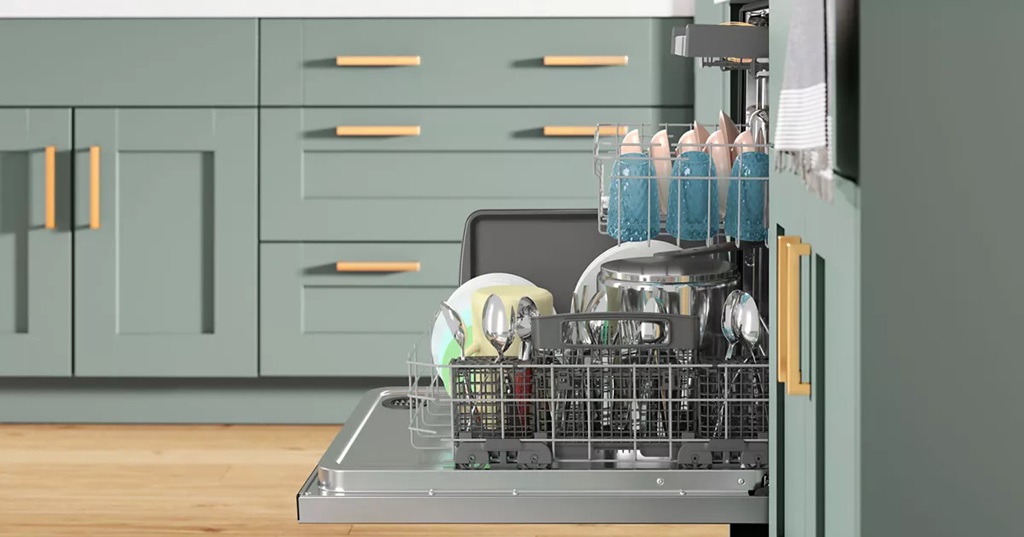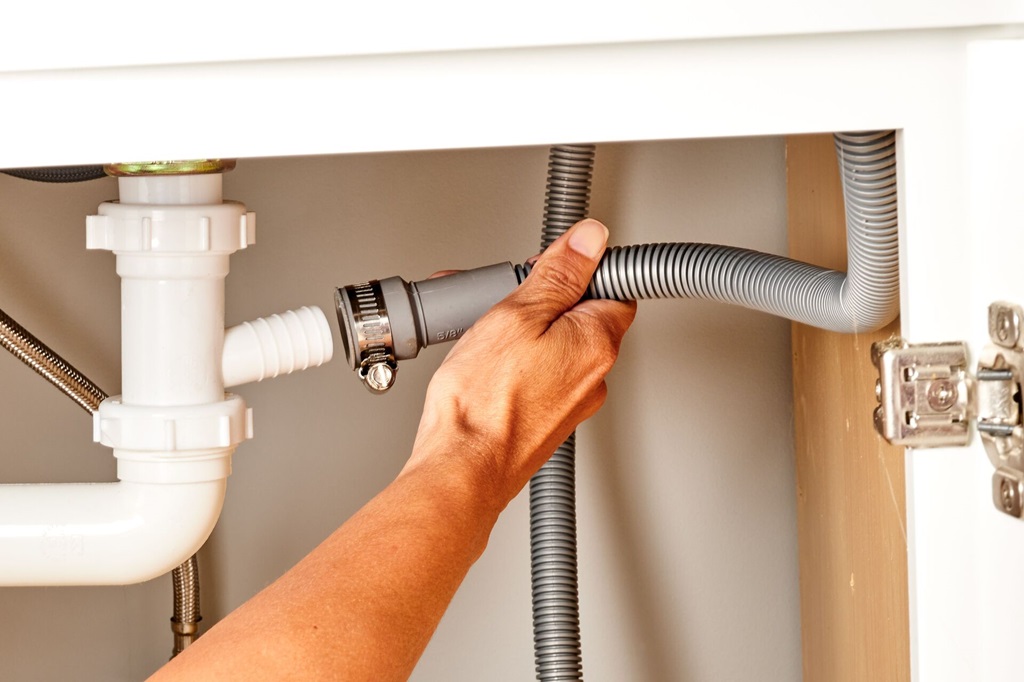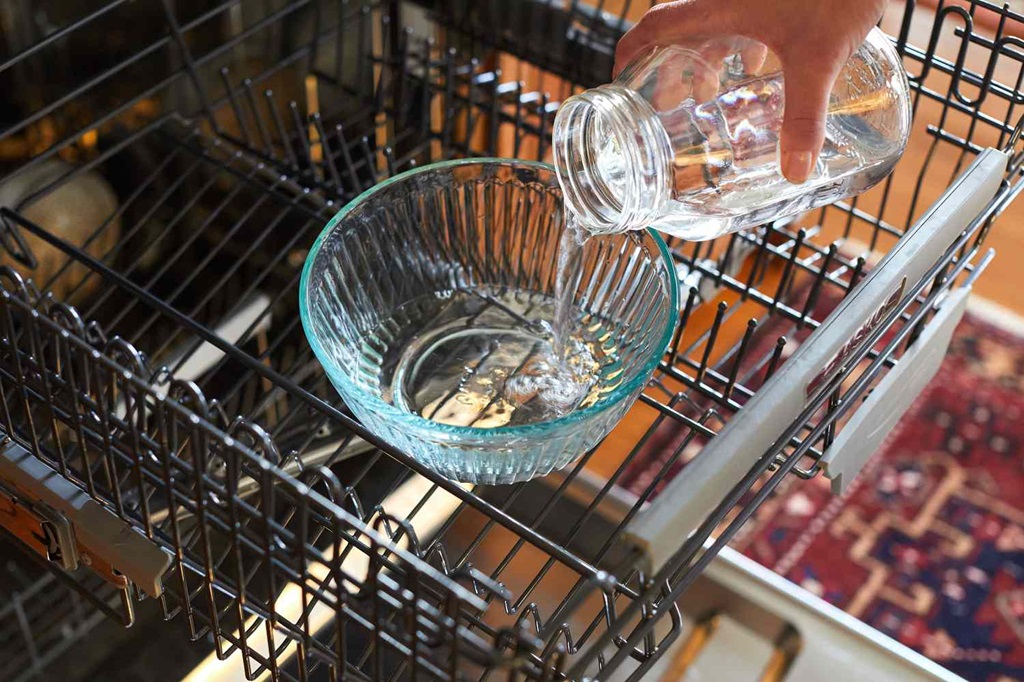
14 Feb How to Clean Smelly Dishwasher Drain Hose?
A dishwasher drain hose is an essential component for allowing wastewater to exit your dishwasher. However, this hose can accumulate food particles, grease, soap scum, and bacteria over time. As a result, it can start to emit foul odors. A smelly drain hose is not only unpleasant, but it’s also unhygienic. The stagnant water provides the perfect breeding ground for bacteria and mold.
Luckily, cleaning a stinky dishwasher hose is a straightforward process. With some simple tools and supplies, you can have it smelling fresh again in no time. I’ll walk you through the steps on how to clean smelly dishwasher drain hose.
Why Does My Dishwasher Drain Hose Smell?
Before diving into the cleaning process, let’s first understand what causes the bad smells in the first place. There are a few common culprits:
Food Debris and Grease Buildup
Leftover food particles and greasy residues easily cling to the inside of the hose. Things like chicken fat, oil, small chunks of food, and sauce remnants all get stuck over time. As this buildup starts rotting and decaying, it gives off a rancid odor.
Soap Scum and Mineral Deposits
The mix of food scraps, water minerals, and dishwasher detergent leaves a layer of filmy soap scum inside the hose. This sticky buildup traps bacteria and emits a sour, musty smell.
Mold and Mildew
The warm, moist environment encourages mold growth. This black or green growth thrives off the food particles and spreads quickly. Mold releases spores and gases that cause unpleasant smells.
Trapped Water and Bacteria
Small puddles of water get trapped in the hose loops and low points. Anaerobic bacteria multiply in this stagnant water and produce sulfur-like odors.
By regularly cleaning the hose, you prevent these smelly buildups from occurring.
Supplies Needed
Cleaning the drain hose involves disconnecting it from the dishwasher and sink. You’ll need the following supplies handy:
- Bucket or basin
- Old towels
- Rubber gloves
- Eye protection
- Vinegar or lemon juice
- Baking soda
- Dish soap
- Scrub brush
- Rags or sponges
- Zip ties (to reattach hose)
Optional extras:
- Face mask
- Clothes you don’t mind getting dirty
Gather all your cleaning gear before getting started. Having everything ready makes the process faster and easier.
Step 1: Disconnect the Hose

The first step is accessing the drain hose by detaching it from the dishwasher and garbage disposal/sink drain. Start by pulling out the dishwasher to improve access to the back. Turn off the dishwasher if it’s still connected to power.
Locate the drain hose attachment point on the dishwasher. There is typically a clamp or compression fitting that secures it in place. Carefully loosen this hardware and slide the hose off of the dishwasher port.
Next, release the hose from the sink drain or garbage disposal. This may involve unscrewing a drain port, releasing a clamp, or simply sliding the hose out. Place a bucket or bin beneath this end of the hose to catch any water that may spill out when released.
With both ends detached, you can now pull the hose out completely to clean it.
Step 2: Direct Drain Hose into Bucket
Position the drain hose over a large bucket or plastic bin. Elevate it approximately 6 inches above the bucket so the water can flow out.
You may need an extra set of hands to hold up the hose while you work on cleaning it. Alternatively, you can use a ladder, step stool, or other sturdy object to prop up the end of the hose over the bucket.
The goal is to let gravity help drain out as much standing water as possible before cleaning the interior. Allow several minutes for it to empty out completely.
Step 3: Flush With Hot Water
With the hose positioned over the bucket, use a faucet sprayer or hose to flush hot water through the tube. This will help loosen and rinse away any loose debris inside.
Aim to flush it out for 2-3 minutes. Avoid using extremely hot water that could potentially damage the hose. Lukewarm water is sufficient for this preliminary rinse.
Check the water emptying into the bucket. It will likely be dirty or murky at first as the flushing dislodges buildup. Continue until the water runs clean.
Step 4: Mix Vinegar or Lemon Juice Solution
Now, it’s time to make a cleaning solution that will dissolve stubborn gunk and sanitize the hose. For this, you can use either vinegar or lemon juice mixed with hot water:
Vinegar Solution
- 1 cup white vinegar
- 1-quart hot water
Lemon Juice Solution
- 1⁄2 cup lemon juice
- 1-quart hot water
Both acids work to help cut through grease, remove soap scum, kill bacteria, and combat odors. Mix the solution so it can be easily poured into the hose.
Step 5: Flush the Hose with a Cleaning Solution
With the drain hose aimed into the bucket, slowly pour the vinegar or lemon juice solution into the elevated opening. Try to coat as much of the interior as possible.
Let the solution sit for 5-10 minutes so the acids can break down the gunk inside. Then flush the hose out again with hot water for a couple of minutes.
Check the bucket to see if the rinse water is still dirty. You may need to repeat steps 4 and 5 again if buildup remains.
Step 6: Scrub With Baking Soda and Dish Soap
For particularly smelly hoses with excessive buildup, some manual scrubbing may be needed. Make a paste with baking soda and dish soap to scour away residues:
- 1⁄4 cup baking soda
- 1 tsp liquid dish detergent
- 2 tbsp hot water
Mix the ingredients together until a spreadable paste forms. Wearing gloves, reach inside the hose and coat the interior with the paste. Scrub vigorously to remove stubborn areas of buildup.
After scrubbing the length of the hose, flush it out again with hot water to rinse away the baking soda cleaner. Check that the water runs clear.
Step 7: Sanitize With Vinegar or Lemon Juice
As a final step, sanitize the interior of the hose by pouring vinegar or lemon juice solution into it again. This kills any lingering bacteria and removes final odors.
Let the hose sit for 15 minutes with the solution inside. After sanitizing, give the hose a final rinse with hot water.
Step 8: Dry Completely
Eliminating moisture in the hose is key to preventing odors from returning quickly. Once cleaned, run a lint-free cloth through the hose to dry up any standing water.
You can also use a hair dryer to force air through and completely dry up the interior. Make sure it’s fully dry before reattaching the hose.
Step 9: Reattach Hose
To finish up, securely reattach the drain hose to the dishwasher port and sink drain/garbage disposal. Make sure all clamps and fittings are tightened properly.
Consider replacing old zip ties or clamps with new ones since they tend to degrade over time. Test that water flows freely by running the dishwasher through a short cycle.
And that covers the complete process of cleaning a smelly dishwasher drain hose! With regular cleaning, you can keep odors at bay.
Tips for Preventing Smells

Here are some extra pointers for cleaning the drain hose fresh between deep cleanings:
- Run the dishwasher with vinegar monthly. Pour 2 cups of vinegar into the bottom of an empty dishwasher. Run a hot cycle to clean the interior.
- Avoid cramming dishes. Overcrowding dishes prevents proper water circulation to rinse and wash.
- Remove stuck food particles after washing. Quickly handwash any dishes with food still stuck on.
- Clean dishwasher filter monthly. Rinse away trapped food debris from the filter.
- Always use a rinse aid. Rinse aid helps remove soap film that causes odors.
- Keep the drain hose as short as possible. Long, coiled hoses collect more gunk.
- Let dishes air dry when possible. Stagnant water leads to smells.
Conclusion
A foul-smelling dishwasher drain hose is a common problem, but thankfully one that can be easily resolved. By regularly deep cleaning the hose using vinegar, lemon juice, and baking soda, you can remove built-up gunk and eliminate odors. Make sure to completely dry out the hose after cleaning. Combine these periodic deep cleanings with preventative measures like vinegar rinses and prompt food particle removal, and your drain hose will stay fresh-smelling for years to come. No more having to hold your breath when unsightly odors waft out each time you load dishes!
Frequently Asked Questions
Q: Can I use bleach instead of vinegar to clean the hose?
A: It’s best to avoid bleach, as it can be damaging to the hose material over time. Vinegar and lemon juice work just as effectively without the harsh chemicals.
Q: My hose is completely clogged, what should I do?
A: First, try flushing the hose with hot water using high pressure from a sprayer nozzle. If it’s still blocked, use a hose cleaning brush or a long flexible de-clogger wire to remove the obstruction. As a last resort, the hose may need replacing if it cannot be cleared.
Q: I have hard water, will this affect my drain hose?
A: Yes, hard water minerals can build up limescale inside the hose over time. Make sure to use detergents designed for hard water to prevent excessive buildup. Consider periodic descaling treatments using vinegar or citric acid to dissolve mineral deposits.
Q: How often should I clean the drain hose?
A: Aim to thoroughly clean the drain hose at least once every 3-4 months. For heavy use or if you notice stronger odors, clean it every 1-2 months. Quick rinses with vinegar can also be done monthly.
Q: There’s still a lingering bad smell after cleaning. What should I do?
A: The smell may be coming from inside the dishwasher itself. Run a vinegar cycle and then a hot wash cycle with dishwasher cleaner to sanitize the interior. If odors persist, the filter may need a deeper cleaning.
Q: Can I prevent smells by keeping the dishwasher door open?
A: No, leaving the dishwasher door open allows moisture to escape, which can lead to mildew odors over time. It’s best to keep the door closed between washes. Be sure to run a full wash cycle at least once a week even if the dishwasher isn’t full.



Sorry, the comment form is closed at this time.